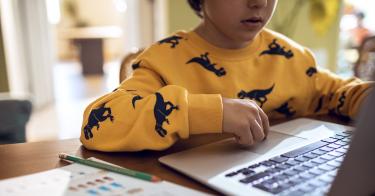Jason Corosanite learned an important lesson this spring: 25 students is too many for a Zoom call.
“When we first went to distance learning,” Corosanite, co-founder of the String Theory Schools public charter school network in Philadelphia, says, “we had all the kids logged on at once.” It didn’t work. As Corosanite explains, students would “turn off, hide in the background.”
School officials have the final word on reopening. “We think being in and in-person to the greatest extent that we can is super important,” Corosanite says.
Across the network’s four campuses, he and his team are now preparing for the fall. “Every day, every week we are getting different guidance from the state level, the local level, and the federal level,” Corosanite says. “Our goal is certainly to get back as soon as we can to classrooms of 25 kids.”
Despite media warnings about increasing numbers of positive COVID-19 tests, new survey results signal that parents want schools to move in that direction—and quickly.
A recent national poll found that 71% of the parents responding felt their children learned less while at home than they would have had schools remained open for in-person classes. Parents were more likely to be dissatisfied with their child’s “required assignments” if they reported communicating with their child’s school less than once per week this spring—and with 40% of respondents saying they did not have weekly meetings with their child’s teacher, this means many parents were left feeling their students were falling through the cracks.
The Trump administration is urging schools to reopen, but these decisions should be left to parents and educators as they evaluate local needs. Dr. Robert Redfield, director of the Centers for Disease Control, said on Thursday that the CDC guidelines for re-opening are “guidance, it’s not requirements,” which again—and appropriately—means families and local educators should make the decisions.
What might these plans look like?
In Philadelphia, String Theory’s example is worth watching. In the 2012-13 school year, the Philadelphia school district tapped Corosanite’s team to turn around a failing district school, and the network has more than 5,000 students on its waiting list.
Crosanite says String Theory will start the semester with half the students attending classes in person on Mondays and Tuesdays, while the other half attends online simultaneously. Officials will clean the schools on Wednesdays, and then the two halves will trade places for Thursdays and Fridays. The school already operates with a longer school day than traditional schools, which will help recoup lost time.
“If we have the capacity to do more, we will do that,” Corosanite says. He explains that this plan was developed after talking with parents and learning that other proposals, such as having groups of students attend for 7 or 8 days straight and then be off for that amount, would be too difficult for families.
Corosanite says, “The most important thing for us is to be as flexible and nimble as possible,” keeping in mind that “a regular, weekly in-person experience for learning is beneficial.”
Public agencies will not have all the answers for local schools, nor can constantly evolving guidance eliminate all the risks from operating a school during a pandemic. State and national guidelines give educators a place to start, but parents, educators, and local officials will best serve students by charting a course based on student needs.
This piece originally appeared in The Philadelphia Inquirer




